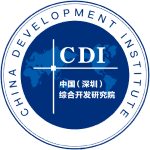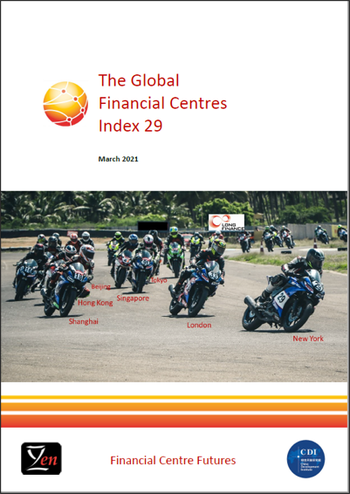Authors
Mike Wardle, Professor Michael Mainelli
Published by
Long Finance & Financial Centre Futures (March 2021), 64 pages. Produced by Z/Yen in Partnership with CDI.
Share on social media:


You might also be interested in:
Global Financial Centres Index 29
The twenty-ninth edition of the Global Financial Centres Index (GFCI 29) was published on 17 March 2021. GFCI 29 provides evaluations of future competitiveness and rankings for 114 financial centres around the world. The GFCI serves as a valuable reference for policy and investment decision-makers.
China Development Institute (CDI) in Shenzhen and Z/Yen Partners in London collaborate in producing the GFCI. The GFCI is updated and published every March and September, and receives considerable attention from the global financial community.
126 financial centres were researched for GFCI 29 of which 114 are now in the main index. The GFCI is compiled using 143 instrumental factors. These quantitative measures are provided by third parties including the World Bank, the Economist Intelligence Unit, the OECD and the United Nations.
The instrumental factors are combined with financial centre assessments provided by respondents to the GFCI online questionnaire. GFCI 29 uses 65,507 assessments from 10,774 respondents.
The results of GFCI 29 include:
- GFCI 29 shows a relatively high level of stability in the top half of the index, with few centres changing 10 or more places in the rankings. In the lower half of the index, there was more volatility, perhaps reflecting some uncertainty about the resilience of emerging and smaller centres.
- The average rating of centres in the index dropped only 3.5 points (-0.55%) from GFCI 28 (41 points from GFCI 27 to GFCI 28), which may indicate more confidence in the financial system than in the first stages of the covid-19 pandemic.
- The fact that overall ratings have not recovered to the levels that we saw in 2019 reflects the continuing uncertainty around international trade, the impact of the covid-19 pandemic, and geopolitical and local unrest.
- Nine of the top 10 centres in the index fell in the ratings, with London and Tokyo falling over 10 points. With the top centres dropping, might this be due to central banks taking the reins during covid-19?
Leading Centres
- New York retains first place in the index. London fell to only one point ahead of third place Shanghai.
- Hong Kong moved up a place to fourth, one point behind Shanghai, with Singapore in fifth position. Tokyo dropped three places from fourth to seventh.
- Frankfurt replaced San Francisco in the top 10 in this edition, gaining seven rank places, perhaps benefiting from the exit of the UK from the European Union.
- Within the top 30 centres, Vancouver, Seoul, Sydney, Milan, and Stuttgart rose by more than five places.
Western Europe
- As in GFCI 28, centres in Western Europe had mixed fortunes in GFCI 29, with 12 centres rising in the rankings and 16 falling. However, the average drop in ratings was just 0.63 points (-0.1%) in this region.
- Berlin entered the index for the first time, ranked 45th.
Asia/Pacific
- Asia/Pacific Centres also had a mixed performance in GFCI 29, with 14 centres falling in the rankings and 14 rising. The change in average ratings for the region was 2.9 points (0.46%).
- Globally, Asia/Pacific centres continue to perform well, with six centres in the top 10 globally. Seoul and Sydney rejoined the top 20 in GFCI 29.
North America
- North American centres showed the least change in the average rating across the regions, falling on average just 0.18 points (-0.03%).
- Vancouver, Washington DC, Chicago, and San Diego all improved five or more places in the rankings.
Eastern Europe & Central Asia
- Overall, this region saw average rating increase by 8.5 points (1.51%), with nine of the 16 centres in the region improving their ratings.
- Moscow, Vilnius, Bratislava, Budapest, and St Petersburg rose five places or more in the rankings.
Middle East & Africa
- Seven centres in the Middle East & Africa improved their ratings in GFCI 29 with Bahrain, Kuwait City, and Tehran improving five or more rank places.
- The average rating in the region rose 9.92 points (1.67%).
Latin America & The Caribbean
- Nine centres rose in the ratings in Latin America & The Caribbean after significant falls in GFCI 28. The average rating in the region rose 11.2 points (1.97%).
- British Virgin Islands, Barbados, and Santiago gained more than 10 places in the rankings.
- Trinidad & Tobago and Bogota entered the index, ranking 97th and 100th respectively.
FinTech
- We are able to rate 105 centres on their Fintech offering.
- New York continues to lead the FinTech ranking, followed by Shanghai, Beijing, Shenzhen, and London.
- Tel Aviv and Los Angeles enter the top 10.




